1. Upon election, what do you plan to accomplish in your first 90 days, what about a year?
The first 90 days is going to be more informative and settling into the role of MLA. From my experience with the City of Yellowknife, this is where we will receive a more in-depth education on the roles and responsibilities. Prioritizing a review from the wildfires has been an action item for me as I have discussed publicly within my role with the City of Yellowknife. Residents need to know we are looking out for their well being, moreover, I am accountable to constituents.
I want to keep in close communication with my riding, ensuring consistent quarterly constituency meetings. If there is few to engage than I will go back to door knocking, let the people know I am there for them.
Within the year, pushing reconciliation further within legislation. The 19th assembly addressed indigenous representation within the public service sector so now is the time to implement and action this. As well, Indigenous governments need to be more involved, partnerships need to be built and nurtured.
2. What are the most pressing issues you plan to address during your time in office?
As a former small business owner, I know the struggles our business sector has had to face. I believe stabilizing our economy must occur before we regrow. We need to diversify our economy to ensure northerners have job creation, training, and growth. Housing, we need to be solution based in our approach to address the funding gap. Having partnerships with the GNWT and Indigenous governments can alleviate the daunting tasks left for NGO’s and developers.
Investing in northerners is a priority in my platform. We have an abundance of skilled individuals; we know northerners are invested in their home’s. Indigenous wellness, ensuring our approaches are in line with the dene laws paired with indigenous healing, the health and well being of indigenous people not only affect the individual suffering but affects all of us.
3. What is your plan to bring workers to the north, and keep residents in the NWT?
I do believe we should make the NWT appealing to outside workers; this can be established by a nation-wide campaign, highlighting the beauty of working and residing in the North. Providing support for newcomers, incentives, the City of Yellowknife has invested in some amazing facilities for residents, promoting the family friendly atmosphere.
I also believe in devoting funds into our existing residents, removing barriers to provide programming and training for these skilled positions, retention is half the battle.
I pledge to advocate for affordable housing which has become a reality towards attracting workers.
4. As housing prices continue to rise, do you have plans to address the needs of those struggling to live in the north?
There is no doubt that housing is a major issue. Affordable housing is not impossible but requires the GNWT to have a robust approach by partnering with Indigenous governments along with developers. Funding is out there, the GNWT needs to be a supporter to initiate compelling packages for funding options such as CMHC. From the City perspective, the process of land transfer needs to push forward for Yellowknife to have vacant land to develop.
By incentivizing retrofits this can decrease the overall cost expenditure for landlords but also for tenants. With the lack of housing, it is impossible for landlords to upgrade, in 2021 the vacancy rate was 1.8%.
5. Due to the rise in drug crime and homelessness in the territory and its communities, can you describe the number one crime-related issue you plan on addressing first?
Addictions. I have been a long-time advocate in this area as I am no stranger to the damaging effects it can have on family. We see it as a community, how devastating it can be. The GNWTs commitment to its residents needs to be solidified in how we are offering programming and support. As homelessness and addiction are more prevalent within the indigenous population, we need to begin the healing with Indigenous practices, addressing the Truth and Reconciliation Commission calls to action #21. There must be a facility for rehabilitation, recovery with support/ programming and a day shelter all separate from each other as their purposes are different and should be treated as such.





